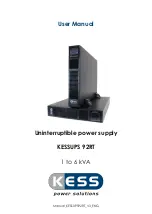
CHALLENGER SERIES 10‐60 KVA
PRODUCT DESCRIPTION
AG–SD‐35 Rev. No:1 Rev. Date:25.09.2013 Publication No:2
15
2.1
General
Information
General operation topology of Challenger
®
Series UPS can be recognized as follows:
The UPS is connected to the mains voltage through the CB1 breaker. As DC bus is ramped up,
the rectifier starts to operate and converts the AC mains to DC voltage. When the mains
voltage is not available, the DC/DC booster pumps the battery voltage to the necessary
level.DC DC bus voltage is then converted to mains synchronized AC voltage by the inverter. .
This is a high quality voltage. Generated AC power is applied loads after static semi‐conductor
switches and output (load) breakers.
2.1.1
Static
Transfer
Switch
Some blocks are named as “static switches” as can be seen above. These blocks consist of
inverse parallel connected thyristors . These switches, which are under the control of the
mainboard control unit (DSP), provides controlling of supplying the loads through either
mains or inverters.. The loads are supplied through inverter during the normal operating
mode. Therefore, Inverter static switches are active if there is no problem with the system.
System provides the loads to be fed smooth and seamless by mains or inverter. In order to
manage his process at minimum risk, UPS sychronizes the inverter output and static (mains)
bypass as phase and frequency. Therefore, Inverter frequency can be considered as mains. It
is the same as mains frequency as long as it is within frequency limit.
User can switch the UPS between mains and inverter by using front panel. While the loads are
fed directly by mains with the order of user, in case of either power off or mains values out of
tolerances, the UPS will start to supply the loads through battery mode.
If the user wants ,can provide mains to feed load continuously by switching on the
maintenance bypass without making adjustment on the front panel. Later on, the user can
make the input and output switch fuses short circuit.














































